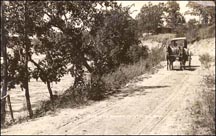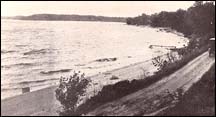View from the Lake-
Autos and horses did not peacefully co-exist
This article submitted by Linda Lorentzen on 08/09/00.
 The new 'Rustic Road' signs have brought attention to the speed limits on the roads around the lake. Today, just as cars, pedestrians, bicyclists, and roller bladers try to co-exist on the lake roads, it is somewhat reminiscent of the days when horse travel and automobile travel were beginning to interfere with each other.
The new 'Rustic Road' signs have brought attention to the speed limits on the roads around the lake. Today, just as cars, pedestrians, bicyclists, and roller bladers try to co-exist on the lake roads, it is somewhat reminiscent of the days when horse travel and automobile travel were beginning to interfere with each other. Horses used the old lake road going east from Grandview Cottages, while the car is traveling west on the same road only closer to the current public swimming beach.
 Dr. Pilon, the first resident of Paynesville to own an automobile, hosted a lunch for the 23 members of an automobile tour. As noted in the August 8, 1912, issue of The Paynesville Press, the tour had left St. Cloud at 8:30 a.m. on a Wednesday morning and planned on a two-day tour, "taking in Paynesville, Glenwood, Alexandria, and Sauk Centre and the intermediate points. They were met two miles east of town by a committee of Paynesville businessmen and piloted to town and to Lake Koronis where they were served with coffee at the two cottages of Dr. P. C. PilonIdle Hours and Revenez-y."
Dr. Pilon, the first resident of Paynesville to own an automobile, hosted a lunch for the 23 members of an automobile tour. As noted in the August 8, 1912, issue of The Paynesville Press, the tour had left St. Cloud at 8:30 a.m. on a Wednesday morning and planned on a two-day tour, "taking in Paynesville, Glenwood, Alexandria, and Sauk Centre and the intermediate points. They were met two miles east of town by a committee of Paynesville businessmen and piloted to town and to Lake Koronis where they were served with coffee at the two cottages of Dr. P. C. PilonIdle Hours and Revenez-y."
Not everyone shared in Dr. Pilon's enthusiasm for the automobile. In the August 22, 1912, issue of The Paynesville Press seven "rules" of the road were presented from an article in the Ripon (Wisconsin) Weekly Press.
1. "Upon discovering an approaching team, the automobilist must stop offside and cover his machine with a blanket painted to correspond with the scenery.
2. The speed limit on country roads this year will be a secret, and the penalty for violation will be $10 for every mile an offender is caught going in excess of it.
3. On approaching a corner where he cannot command a view of the road ahead, the automobilist must stop not less than a hundred yards from the turn, toot his horn, ring a bell, fire a revolver, and send up three bombs at intervals of five minutes.
4. Automobiles must be seasonable painted. That is, so they will merge with the pastoral ensemble and not be startling. They must be green in spring, golden in summer, red in autumn, and white in winter.
5. All members of the society will give up Sunday to chasing automobiles, shooting and shouting at them, making arrests, and otherwise discouraging country touring of that day.
6. In case a horse will not pass an automobile, the automobilist will take the machine apart as rapidly as possible and conceal the parts in the grass.
7. In case an automobile approaches a farm house when the roads are dusty, it will slow down to one mile an hour and the chauffeur will lay the dust with a hand sprinkler worked over the dashboard."
In the same issue of The Press was a short article about an auto party from Grove City. Seven families set out in five automobiles to travel to Lake Koronis for a picnic. The visitors to the lake included the families of N. E. Christenson, Charles Nelson, A. O. Hanson, Edwin and Odin Erickson, Fritz Nelson, and George Hedner. "The party got scattered coming to the lake and some did not get there until about 2:30. Fritz Nelson says it is 41 miles from Grove City to Stony Point by his speedometer. He got separated from the others and made a complete circle of the lake including Paynesville village."
Through the years, the automobile versus horse controversy dwindled. Peaceful existence came to pass as more and more people realized the benefits of automobile travel. For Lake Koronis, the automobile has provided a mode of transportation that has allowed many to come to her shores from much greater distances than if it did not exist. Now, we just have to pay attention to the Rustic Road signs and stick to the noted speed limits to provide a safer existence for people in all modes of modern transportation to enjoy a view from the lake.
Return to Viewpoint page
Archived View of the Lake articles
 Dr. Pilon, the first resident of Paynesville to own an automobile, hosted a lunch for the 23 members of an automobile tour. As noted in the August 8, 1912, issue of The Paynesville Press, the tour had left St. Cloud at 8:30 a.m. on a Wednesday morning and planned on a two-day tour, "taking in Paynesville, Glenwood, Alexandria, and Sauk Centre and the intermediate points. They were met two miles east of town by a committee of Paynesville businessmen and piloted to town and to Lake Koronis where they were served with coffee at the two cottages of Dr. P. C. PilonIdle Hours and Revenez-y."
Dr. Pilon, the first resident of Paynesville to own an automobile, hosted a lunch for the 23 members of an automobile tour. As noted in the August 8, 1912, issue of The Paynesville Press, the tour had left St. Cloud at 8:30 a.m. on a Wednesday morning and planned on a two-day tour, "taking in Paynesville, Glenwood, Alexandria, and Sauk Centre and the intermediate points. They were met two miles east of town by a committee of Paynesville businessmen and piloted to town and to Lake Koronis where they were served with coffee at the two cottages of Dr. P. C. PilonIdle Hours and Revenez-y." The new 'Rustic Road' signs have brought attention to the speed limits on the roads around the lake. Today, just as cars, pedestrians, bicyclists, and roller bladers try to co-exist on the lake roads, it is somewhat reminiscent of the days when horse travel and automobile travel were beginning to interfere with each other.
The new 'Rustic Road' signs have brought attention to the speed limits on the roads around the lake. Today, just as cars, pedestrians, bicyclists, and roller bladers try to co-exist on the lake roads, it is somewhat reminiscent of the days when horse travel and automobile travel were beginning to interfere with each other.